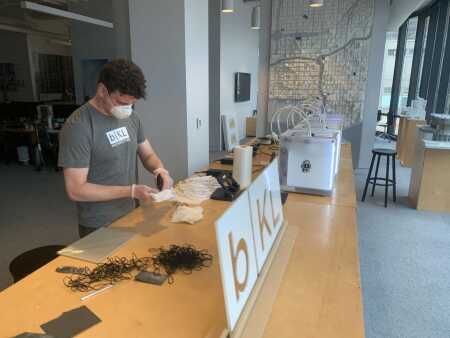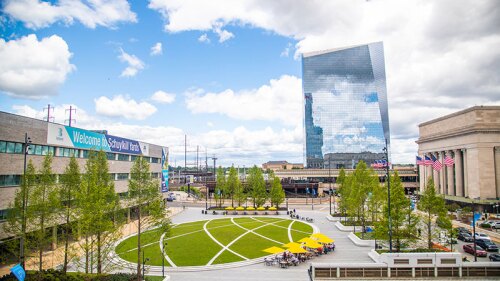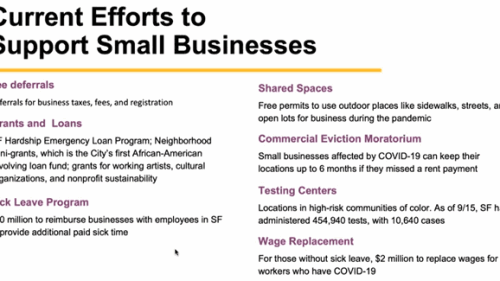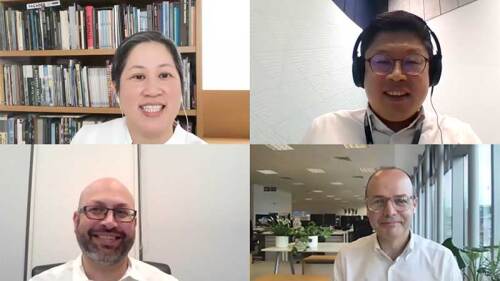ULI members are mobilizing their businesses to serve urgent needs in their communities in the time of COVID-19. Many of these projects are focused on supporting health care workers on the front lines, as well as the small businesses and low-income communities reeling from the sudden economic impacts.
“New York City has transformed almost overnight, where we have gone from an intense, connected community to people in isolation and empty streets,” says Jay Valgora, founder and principal of Studio V Architecture, based in New York City. “Social distancing does not have to be social isolation. We all want to help. And we learned the hard way that we were not prepared,” he says.
Valgora also noted that the experience of dealing with the pandemic shows that resilience—the ability to respond to, adapt to, and recover from sudden shocks as well as long-term stresses—is more urgent and evident than ever.
As cities and hospitals seek out space for much-needed critical facilities and essential services, many people working in real estate and land use have helped identify new spaces and have thought creatively about how to optimize existing spaces for new uses. Thousands of hotel rooms are being leased to be used as temporary medical facilities. Other emergency-level adaptive use initiatives, mostly led by city agencies, are taking place in convention centers, parking garages, college dormitories, and sports fields and stadiums.
Some businesses also have a need to shift traditional workspace for essential workers into space compatible with social distancing. For example, JLL recently supported Delta Air Lines in repurposing a hangar into a new call center required to support urgent customer needs in accordance with Centers for Disease Control and Prevention (CDC) space guidelines.
To identifylocal opportunities, the New York city and state chapters of the AmericanInstitute of Architects created a grassroots network of architects, real estateprofessionals, engineers, and others to volunteer services for New York statein the case that there is a need to build and/or adapt structures for emergencyuse. So far, more than 50 firms have added to a shared Google document a widerange of offerings, such as providing structural evaluations, fitout support,community space, and design and development support.
Some designfirms are focusing on how to use their skill sets and technologies to servehealth care workers on the front lines. Partnering with Weill Cornell Medical Collegein New York City, Studio V is one of several architecture firms within the ULImembership deploying their 3-D printing equipment and design expertise toassist health care workers through the creation of personal protectiveequipment (PPE) such as face shields, visors, and masks. Hospitals across thecountry have been woefully understocked with PPE, leaving medical professionalsto put themselves at severe risk of infection by using homemade or reusedequipment. Face visors and shields, typically made of thin plastic, provide asecond layer of protection on top of conventional hospital masks.
Boston-based CBT model shop director Aaron Williams brought CBT’s 3-D printer home when its offices closed and found an open-source mask design called the NanoHack Mask online. The design is for a reusable device that holds a portion of a standard N95 mask. CBT determined it was plausible to print each mask in about two and a half hours and began making masks for Boston area health care workers. Williams also joined an Innovation Group spearheaded by Massachusetts General Hospital and other local medical institutions.
Chicago-based bKL Architecture is now producing about 1,000 shields per week with the firm’s 3-D printers. When founding principal Thomas Kerwin realized that there was a larger need in the community beyond what they could initially print, he launched a GoFundMe page to purchase materials and additional 3-D printers to ramp up their home-grown operation, quickly raising $40,000.
“The localreal estate community really stepped up and donated,” Kerwin says. “We havealmost 300 donations representing 50 companies that are real estate firms, clients,construction partners, engineering partners.”
The fundraiser allowed the firm to purchase eight additional 3-D printers, which will be donated to Chicago Public Schools and the Chicago Public Library after the COVID-19 crisis subsides or PPE becomes more widely available. Then, bKL partnered with group Get Me PPE Chicago, an organization led by medical students, to facilitate the distribution of face shields directly to health care workers at the University of Chicago Medical Center and other underserved hospitals in California, New Jersey, Pennsylvania, New York, and Toronto.
“Thegracious response from doctors, nurses, and health care professionals has beenamazing, and we immediately divert that thanks back to them as the heroes ofour time,” says Kerwin. The firm has also emailed the digital file, providedfrom an open source, and the 3-D printing instructions to other design firmsacross North America.
Othermembers have focused on ways to support their communities’ small businesses andorganizations serving the most vulnerable populations and those affected bysudden job losses. In Northern California, the Sares Regis Group, a real estatedevelopment, investment, and management firm, established the Sares RegisEducation and Community Foundation COVID-19 Relief Initiative to providefinancial support to address the immediate and critical needs of organizationsserving vulnerable members of their community.
“We intendto use our own resources and join with others by connecting the dots betweenthe need and the resource,” says Rob Wagner, managing director of Sares RegisGroup of Northern California. “This includes, but is not limited to, thefollowing priorities: at-risk individuals and families, small businesses,students, and those on the front lines of the response effort.”
As of earlyApril, 14 local organizations had received grants totaling $100,000.
Wagnernotes, “The landscape of COVID-19 relief can be a little overwhelming, but ifeverybody could take a moment to stop and think about connecting with those inneed—just like we would in our typical business day before COVID—we can allmake a big difference.”
Williamsadds that “supportive, responsive efforts like these are community efforts attheir core and wouldn’t be possible without communication across disciplinesand industries. As members of a wide professional network, I think our voicescan have a real impact in spreading awareness of the problems and solutions atthis time, and they offer important contributions in this fight.”
“ULI plays a key role in our communities,” says Valgora. “And this crisis is helping us reevaluate the roles we all play and how we can do more.”




